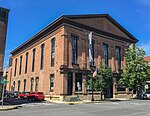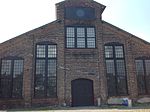New York Training School for Girls
1904 establishments in New York (state)1975 disestablishments in New York (state)Buildings and structures in Columbia County, New YorkHudson, New YorkJuvenile law ... and 2 more
Prisons in New York (state)Women's education in New York (state)
New York Training School for Girls in Hudson was a reformatory school, where teenage girls, between the ages of 12 and 16, who were convicted of any form of juvenile delinquency in New York state were sent. The institution operated between 1904 and 1975. Since 1976 it has been a minimum security prison for young male adults, recently called Hudson Correctional Facility. It is famous for the sociometric research done by Jacob Moreno and Helen Jennings in the 1930s.
Excerpt from the Wikipedia article New York Training School for Girls (License: CC BY-SA 3.0, Authors).New York Training School for Girls
East Court Street,
Geographical coordinates (GPS) Address Nearby Places Show on map
Geographical coordinates (GPS)
| Latitude | Longitude |
|---|---|
| N 42.2439 ° | E -73.7935 ° |
Address
Stewart Hall
East Court Street 50
12534
New York, United States
Open on Google Maps








